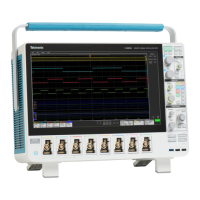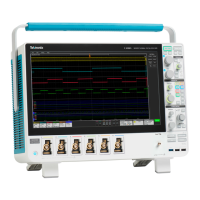Commands listed in alphabetical order
Arguments
0 displays seve
n-bit slave addresses as integers in the range of 0 to 127, with
the state of the R/W* bit from the LSB of the slave address byte. For example,
the slave address byte of 0b10100101 is displayed as the value 0x52 R.
1 displays the entire slave address byte as a number, with the R/W* signal as its
LSB (bit 0) and the slave address in bits 7..1. For example, the slave address byte
of 0b10100101 is displayed as the value 0xA5 R.
Examples
BUS:B1:I2C:RWINADDR 0 displays seven-bit slave addresses as integers in
the range of 0 to 127.
BUS:B1:I2C:RWINADDR? might return :BUS:B1:I 2C:RWINADDR 1, indicating
that the entire slave address byte is displayed as a number, with the R/W* signal
as its LSB (bit 0) and the slave address in bits 7..1.
BUS:B<x>:LABel:COLor
This command sets or queries the color of the specified bus label. The bus is
specified by x.
Group
Bus
Syntax
BUS:B<x>:LABel:COLor <QString>
BUS:B<x>:LABel:COLor?
Arguments
<QString> is the bus label color. To return the color to the default color, send an
emptystringasinthisexample:
:BUS:B1:LABEL:COLOR "".
Examples
BUS:B1:LABel:COLor "#FF0000" sets the label color to red.
BUS:B1:LABel:COLor? might return :BUS:B1:LABEL:COLOR "#FF0000"
indicating the color is red.
BUS:B<x>:LABel:FONT:BOLD
This command sets or queries the bold state of the specified bus label. The bus
is specified by x.
Group
Bus
Syntax
BUS:B<x>:LABel:FONT:BOLD {ON|OFF|1|0}
BUS:B<x>:LABel:FONT:BOLD?
MSO54, MSO56, MSO58, MSO58LP Programmer 2-147
